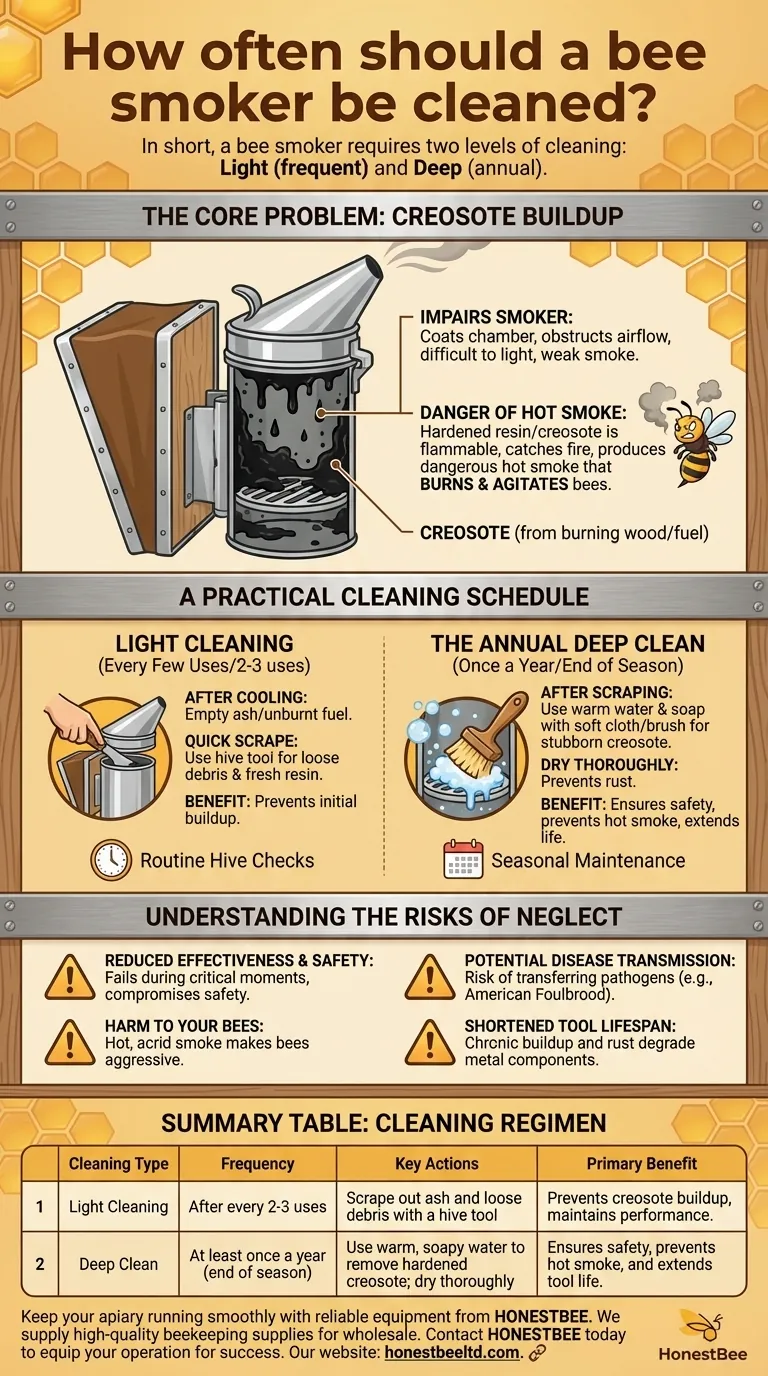In short, a bee smoker requires two levels of cleaning. You should perform a light cleaning after every few uses to maintain performance, and a comprehensive deep clean at least once a year to remove heavy buildup and ensure the tool's longevity.
The core reason for cleaning a bee smoker is not simple tidiness, but function and safety. A dirty smoker, clogged with resinous creosote, will fail to produce cool, white smoke, potentially agitating your bees and compromising your ability to manage the hive safely.

The Core Problem: Creosote Buildup
A smoker's primary enemy is creosote, a black, tar-like substance that is a natural byproduct of burning wood and other organic fuels.
How Buildup Impairs Your Smoker
As creosote accumulates, it coats the inside of the smoke chamber and the grate.
This buildup physically obstructs airflow, making the smoker difficult to light and preventing it from producing a sufficient volume of smoke.
The Danger of Hot Smoke
More importantly, hardened resin and creosote are flammable.
This buildup can catch fire inside the chamber, producing dangerously hot smoke that will burn and agitate your bees rather than calming them.
A Practical Cleaning Schedule
Adopting a two-tiered cleaning schedule prevents most issues and extends the life of your smoker.
Light Cleaning (After Every Few Uses)
After your smoker has completely cooled, empty any remaining unburnt fuel and ash.
Use a hive tool to quickly scrape out any loose debris or fresh resin from the chamber. This simple step prevents the initial buildup from hardening.
The Annual Deep Clean
Once a year, typically at the end of the beekeeping season, perform a deep clean.
After scraping out all solid material, use warm water and soap with a soft cloth or brush to dissolve stubborn, caked-on creosote. Ensure the smoker is dried thoroughly to prevent rust.
Understanding the Risks of Neglect
Ignoring smoker maintenance introduces unnecessary risks and inefficiencies into your beekeeping practice.
Reduced Effectiveness and Safety
A smoker that is difficult to light or produces weak smoke can fail you at a critical moment during a hive inspection. This compromises your safety when dealing with a defensive colony.
Harm to Your Bees
As noted, a dirty smoker can produce hot, acrid smoke that harms bees and makes them more aggressive, defeating the entire purpose of using the tool.
Potential for Disease Transmission
While a lesser risk, a dirty smoker can be a vector for transferring pathogens like American Foulbrood spores between different hives if not cleaned regularly.
Shortened Tool Lifespan
Chronic creosote buildup and the resulting rust from trapped moisture will degrade the metal components of your smoker, forcing you to replace it sooner.
Making the Right Choice for Your Goal
A clean smoker is foundational to calm, confident hive management. Use this simple regimen to keep your tool in optimal condition.
- For routine hive checks: Perform a quick scrape-out after every 2-3 uses to ensure reliable smoke production and prevent heavy buildup.
- For seasonal maintenance: Conduct a thorough deep clean with soap and water at the end of each beekeeping season to reset the tool for the next year.
- If you notice poor performance: Clean your smoker immediately if it becomes difficult to light or produces weak, ineffective smoke.
Properly maintaining your smoker is a direct investment in the health of your bees and the safety of your work.
Summary Table:
| Cleaning Type | Frequency | Key Actions | Primary Benefit |
|---|---|---|---|
| Light Cleaning | After every 2-3 uses | Scrape out ash and loose debris with a hive tool. | Prevents creosote buildup, maintains performance. |
| Deep Clean | At least once a year (end of season) | Use warm, soapy water to remove hardened creosote; dry thoroughly. | Ensures safety, prevents hot smoke, and extends tool life. |
Keep your apiary running smoothly with reliable equipment from HONESTBEE. A properly maintained bee smoker is just one part of successful beekeeping. We supply commercial apiaries and beekeeping equipment distributors with high-quality, durable beekeeping supplies and equipment through our wholesale-focused operations. Ensure your tools are as dependable as your practice. Contact HONESTBEE today to discuss your wholesale needs and equip your operation for success.
Visual Guide

Related Products
- Premium Traditional Copper Bee Smoker with Bellows
- Economy Galvanized Beekeeping Honey Bee Smoker for Wholesale
- European Stainless Steel Bee Smoker for Honey Bee Hive
- Stainless Steel Honey Bee Smoker Hive and Honeycomb Smoker for Beekeeping
- Heavy Duty Manual Bee Smoker Blower for Beekeeping
People Also Ask
- What are the benefits of using smoke properly in beekeeping? Achieve Calm, Safe Hive Inspections
- How did early beekeepers use bee smokers? Master Ancient Bee Calming Techniques
- What is the primary purpose of using smoke in beekeeping? Calm Bees for Safer Hive Management
- How does water mist work as an alternative to smoke in beehives? A Guide to Safe & Effective Use
- What are the main parts of a bee smoker? Essential Components for Calm Hive Management



















